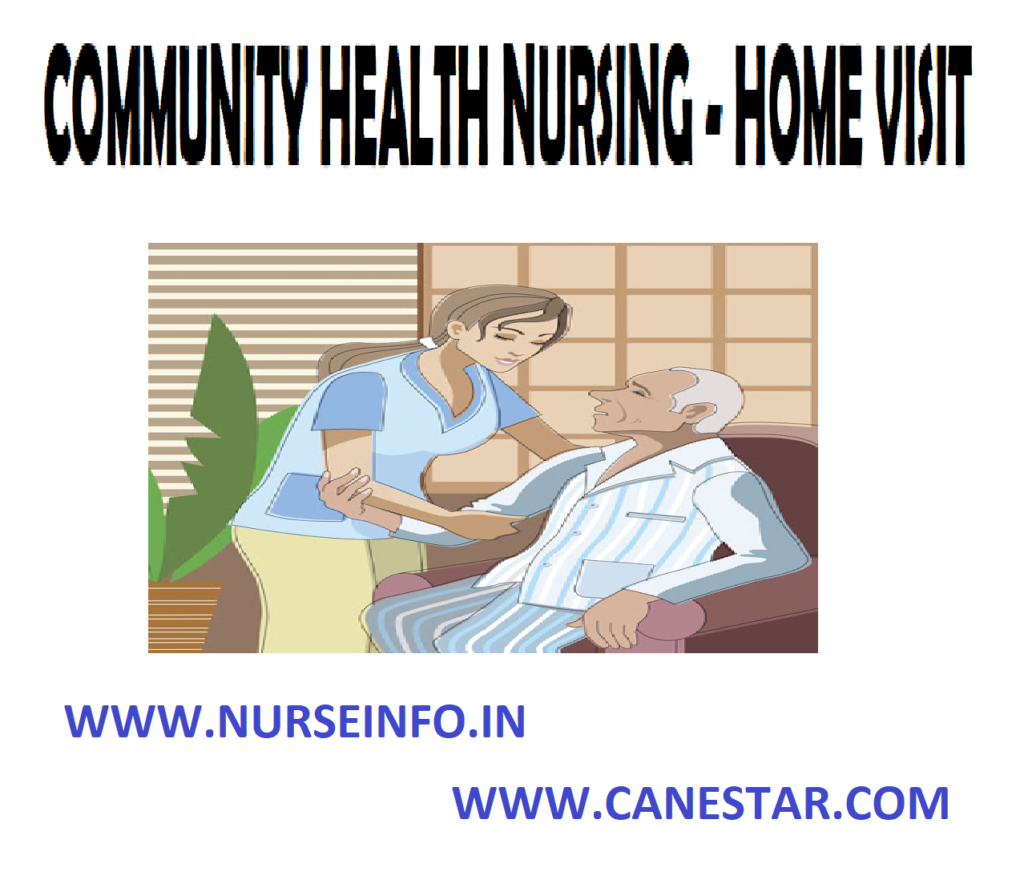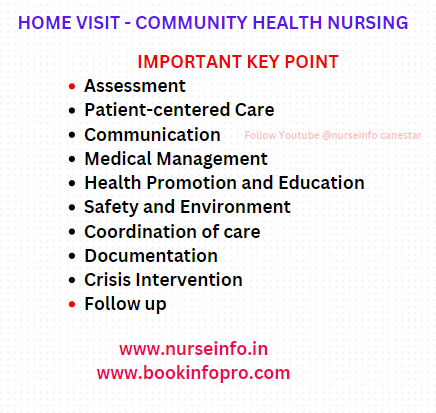HOME VISIT – COMMUNITY HEALTH NURSING (Concept of Home Visiting, Purposes, Principles, Steps and Advantages)
Updated 2024
HOME VISIT
Home visits are an integral part of community health nursing, allowing healthcare professionals to provide personalized care and support to individuals and families within their homes.
The community health nurse work with families is in different settings including clinics, schools, support groups, office and the family home. Home visits give a more accurate assessment of the family structure and behavior in the natural environment
Home visits also provide opportunities to observe the home environment and to identify barriers and support for reaching family health promotion goods. Health services in the home requires technical skills, knowledge of preventive and therapeutic measures, teaching ability, judgment and a full understanding of human relations
Home visit refers to meeting the health needs of people at their doorsteps. Health services given at home for patient, family and the community in general for nursing service and health counseling
CONCEPTS OF HOME VISITING
- Home visiting provides opportunity to make direct observation on home environment, family structure, familial roles and relationships, life style, cultural practices, group dynamics, etc. and make family health assessment.
- In home visiting the members are relaxed, have more time and privacy and feel free to raise questions, seek clarifications and sort out their problems
- It provides opportunities to make direct observation of care given by family members in planning and implementing family health care services
- It provides opportunities to contact and interact with most of the family members and establish report with the family as a whole
- It also make possible to have active participation of family members in planning and implementing family health care
- It makes feasible to plan and provide comprehensive family health care with major emphasis on promotive and preventive care
PURPOSES OF HOME VISITING
- It is a routine part of a planned visiting program by community health personnel
- It helps to investigate the source of infectious diseases
- To do follow up on some problems identified in the health center, school, industry or hospital
- To assess the nutritional and immunization status, environmental hazards
- To give health education to the individual, family and community
- To supervise and guide other health workers
PRINCIPLES OF HOME VISITING
- Need Based: home visiting should be planned and conducted based on the identified needs of the people
- Priority based: the home visit should give to the existing problem in the family. It may be maternal and child health services or antenatal checkup
- Regularity: plan for regular home visiting programs based on family needs. It should be conducted at regular intervals
- Flexibility: the community health nurse should adopt a flexible approach based on prevailing circumstances at home
- Scientific based: be sure of the scientific soundness of the subjects used for discussion. Use of technical skills includes hand washing an inspection
- Analysis based: collect facts about the home, the patient and the environment and make an objective analysis of the facts as an initial step in visiting the home
- Developing relationship: work with the person and family plan jointly. Home visiting helps to establish good working relationship in the family
- Sensitivity: the community health nurse should be sensitive to the persons feeling and needs at the time of the visit. Listen to the family and understand the other person’s point of view
- Educative: evaluate your own work remember the quality of care is more important than the number of home visits. It is essential to evaluate home visits from time to time
STEPS IN HOME VISITING
- Initial phase: the community health nurse should collect information from clinical and other records before planning for a visit. During home visit, she has to assess or observe and make a note in initial visit
The community health nurse should introduce and establish a friendly relationship by using simple language. Assess physical and environmental status, family’s cultural background, occupation and income of family members, age, educational factors and psychological factors influences
- Action phase: the interpersonal relationship starts when nurse enters into the house. The nurse should use their effective communication skills to implement the nursing process. During home visit, nurse practice a variety of roles when interviewing in patient care. The community health nurse has to take a role as collaborator, consultant, co-coordinator, preventor of disease, promoter of health, health educator and an epidemiologist, and takes steps to implement nursing process
During action phase the community health nurse provides nursing care, e.g. taking temperature, physical examination and dressing, etc. demonstrating and teaching, e.g. teaching insulin self-administration. She makes diagnosis and tentative nursing care plan based on establishing priorities
- Termination phase: nurse-patient goals are reached, health is restored and the patient can function without actions. The nurse records the important events in the family and reports the problems of the family. Evaluation of home visit is a continuous process
ADVANTAGES OF HOME VISIT
- The nurse can directly observe home and family atmosphere
- The nurse can directly observe the care given to patient by the family members
- It is possible to discover new health problems
- The family members will be more relaxed in their own surroundings
- The family gains confidence and feels to clear their doubts
- This helps to apply the gained knowledge and skills in the homes assisting and solving individuals and families health problems

NURSING PROCEDURES LIST CLICK HERE
NURSING IMPORTANT QUESTIONS – CLICK HERE
KEY COMPONENTS IN HOME VISITS
1. Assessment:
- Conduct a thorough assessment of the home environment, including living conditions, safety hazards, and available support systems.
2. Purpose of the Visit:
- Clearly define the purpose of the home visit, whether it is for routine check-ups, health education, medication management, post-discharge follow-up, or addressing specific health concerns.
3. Appointment and Consent:
- Schedule home visits at convenient times for the client and obtain consent for the visit. Respect the client’s privacy and autonomy.
4. Communication:
- Establish effective communication with the client and their family. Listen actively, address concerns, and encourage open dialogue to better understand their needs.
5. Cultural Competence:
- Be culturally competent and respectful of the client’s cultural practices, beliefs, and values. Consider cultural factors when planning and delivering care.
6. Safety Precautions:
- Assess and address safety concerns in the home, including fall risks, fire hazards, and other environmental factors. Provide education on maintaining a safe living space.
7. Medication Management:
- Review medications with the client, ensuring proper administration and understanding. Address any concerns or questions regarding medications.
8. Health Education:
- Provide individualized health education on topics such as chronic disease management, nutrition, hygiene, and preventive care. Use visual aids and written materials as needed.
9. Family Involvement:
- Involve family members or caregivers in the care plan, as appropriate. Consider their support and collaboration in maintaining the client’s health.
10. Health Promotion: – Encourage and facilitate healthy lifestyle choices. Discuss strategies for maintaining or improving health and preventing illness.
11. Assessment of Activities of Daily Living (ADLs): – Evaluate the client’s ability to perform daily activities, such as bathing, dressing, and eating. Provide assistance or make recommendations for improvement as needed.
12. Monitoring and Follow-up: – Establish a plan for ongoing monitoring and follow-up. Determine the frequency of home visits based on the client’s needs and the nature of the healthcare issue.
13. Documentation: – Document the home visit thoroughly, including assessments, interventions, education provided, and any changes in the client’s health status. Maintain accurate and up-to-date records.
14. Collaboration with Other Healthcare Providers: – Collaborate with other healthcare professionals involved in the client’s care, such as physicians, therapists, and social workers. Ensure a coordinated and holistic approach.
15. Respect for Autonomy: – Respect the client’s autonomy and involve them in decision-making regarding their care. Encourage them to express their preferences and goals for health and well-being.


